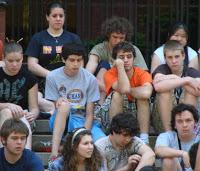Whole Brain Teaching Wednesday! Teach-Ok

Today is our first Whole Brain Teaching Wednesday, a special post dedicated to highlighting a specific WBT strategy in more detail than I do during some of my regular posts where I discuss my education classes as well. To kick it off our first WBT-W I would like to start with “Teach-Ok”.

“Teach-Ok” is a formative assessment tool that allows for you, as the teacher, to gauge student’s comprehension on the topics you’re teaching. This strategy, however, is not your average worksheet that bores your students, requires hours of marking and kills trees!
Studies have shown that when the primary cortices of the brain are engaged simultaneously, information is more easily stored in long-term memory. This strategy engages your students visually, verbally, mentally and physically! In addition, it is fun for both the students and the teacher, which engages the emotional system of the brain as well.
Who amongst us can honestly say that they haven’t had students that look like the picture above? We know that the longer we lecture in front of a class, the more students we lose to boredom. The “Teach-Ok” strategy shortens the time that you, as the teacher, spend lecturing at one time. It does not shorten how MUCH content you cover, it just changes how you DELIVER the content. The following describes the “Teach-Ok” content as it is stated by Jeff Battle on the Whole Brain Teaching website.

Essentially, many teachers do use strategies similar to this idea. Just think of how many times you have your students discuss a topic with their partner or table group before you go on to a new idea. This strategy follows this basic idea but with a more structured and purposeful layout. Remember, you want to ensure that you are presenting information in shorter chunks and encouraging visual, verbal, mental and physical engagement!
I used this strategy in my last student teaching placement and the students LOVED it. It was incredibly engaging and I didn’t have any students zoning out because they don’t have an opportunity to! One thing that I do recommend is that you chose your pairings with careful consideration to your students personalities to ensure that students will be able to concentrate on the co-teaching component (sometimes certain students can just not teach effectively to one another), but with some management it works great. I was able to have full engagement from 30 grade 10 students, with a large distribution of abilities, at 10 in the morning!
Check out the Whole Brain Teaching website to see Jeff Battle’s instructions in context or check out Chris Biffle’s YouTube channel to see this strategy in action
Hello Miss L,
It's fantastic that you are beginning your career with WBT, integrating technology and using VARK strategies to help learning stick. I am a learning assistant teacher in Delta BC doing my masters in technology, with a focus on UDL and building community in classrooms and schools.
I will check out Jeff Battle's WBT website. You should check our Dr.Judy Willis, neurologist and teacher, who has created webinars based on brain research, how to make learning stick, building memory and many other topics. She also has a website with information and resources. radteach.com/
Love learning along with you! Your blog is great.
This seems like a great idea! I can't wait to learn more about this Whole Brain Teaching idea… I don't think I know enough about it yet to try it in STUDENT teaching, but maybe by the time I get my own classroom I can start using it!
Jackie, thank you so much! I will continue regularly posting as well as feature WBT Wednesdays. I look forward to your thoughts as we go through more strategies.
Angel, WBT is a lot of fun! I only used a few strategies during my student teaching placement as there are SO many aspects of WBT that you can include. One of my reasons for starting this blog was so that I could try to learn as much as possible before getting my own classroom so we are in the same boat!
Help please,
You write, "Studies have shown that when the primary cortices of the brain are engaged simultaneously, information is more easily stored in long-term memory."
I searched unsuccessfully to find any studies supporting this. Which studies are you referring to?
"This is an excellent oppurtunity to monitor student comprehension?" I don't think so. All the students are doing is repeating what you just said. That doesn't mean they comprehend it.
Every WBT video I've ever seen shows the kids repeating exactly what the teacher said in "teach/OK". Often, they barely have enough time to even do that before they're told to switch (have the other kid talk.)
I think you're not really doing WBT, which is very good news.